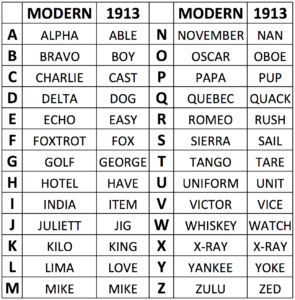
Ever since its establishment, it has become almost like a universal language that’s being used until today. The final version of the military alphabet was only decided on after testing it many times under scientific observation and study. These word assignments allowed for the expression of letter and number combinations to be said in such a way that will be understood by anyone, especially when the message was sent over the phone or radio.
US ARMY SPELLING ALPHABET CODE
The International Radiotelephony Spelling Alphabet, also called the ICAO spelling alphabet or simply NATO phonetic alphabet, was developed with the primary purpose of clearing up misunderstandings caused by how people pronounce words differently.įor this to be possible, code words were assigned to each of the letters in the English alphabet. How the NATO Alphabet Was Formed and Selected The NATO alphabet has always been the go-to communication format for various sectors when parties need to ensure that their messages and words are sent across and received accurately.

While the radio communications industry has moved on in terms of technical sophistication, the military phonetic alphabet is still used from time to time to clarify confusing and unclear messages, especially in the case of bad reception.

The NATO phonetic alphabet is a spelling alphabet that eliminates the issues that arise from differences in languages, accents, and pronunciations. Technically, the NATO military alphabet is not exactly a phonetic alphabet, since phonetic alphabets are those that help people learn the pronunciation of words depending on the language. However, letters such as D and B, M and N, C and Z, sounded so similar to each other that crews and operators oftentimes had difficulty correctly identifying them. All planes and flights were given names that had identifying letters. Originally, it was developed to provide a standardized way for aviation crews around the world to easily make themselves understood and recognized. Why Was the NATO Phonetic Alphabet/Military Alphabet Created? What made it unique and at the same time, easy to adopt, is it assigned unique words for every letter of the alphabet, allowing everyone who knows it deliver their messages more clearly. When the military alphabet was standardized in 1956 and turned into a universal military alphabet a few years later, it has been used not only for military communication, but civilian and amateur radio communications as well. The NATO alphabet seeks to transcend beyond regional differences, including accents and pronunciations. The NATO phonetic alphabet is widely used to prevent spelling and miscommunication errors, especially when people or groups from different countries with different languages communicate. Z – Zulu The NATO Phonetic Alphabet As a Spelling Standard Meanwhile, some standards, such as the Morse code, were used less and less. For instance, those in the naval field still use flag signals to communicate. However, it is good to note that even though the phonetic alphabet is widely used and accepted, some sectors also use other codes and communication standards.

If you’ve ever said “Charlie” to clarify to someone you’re talking to on the phone that you meant the letter “C”, not “Z”, it means you’re familiar with the standard NATO phonetic alphabet, also known as “the military alphabet”. Some refer to it simply as the Alpha, Bravo, Charlie alphabet. It is also called the NATO phonetic alphabet. It was officially termed as the International Radiotelephony Spelling Alphabet.

NATO formally adopted and used the final version of the phonetic alphabet spelling format on January 1, 1956. However, standardizing said formats allowed for communication methods that are understood by all, regardless of their position in the armed forces and anywhere in the world they may be. To ensure clear communication between involved authorities and parties, the North Atlantic Treaty Organization (NATO) has been utilizing various phonetic spelling alphabet formats that were well-known to militaries across the world. NATO Phonetic Alphabet, The Military Alphabet And Its Letters


 0 kommentar(er)
0 kommentar(er)
